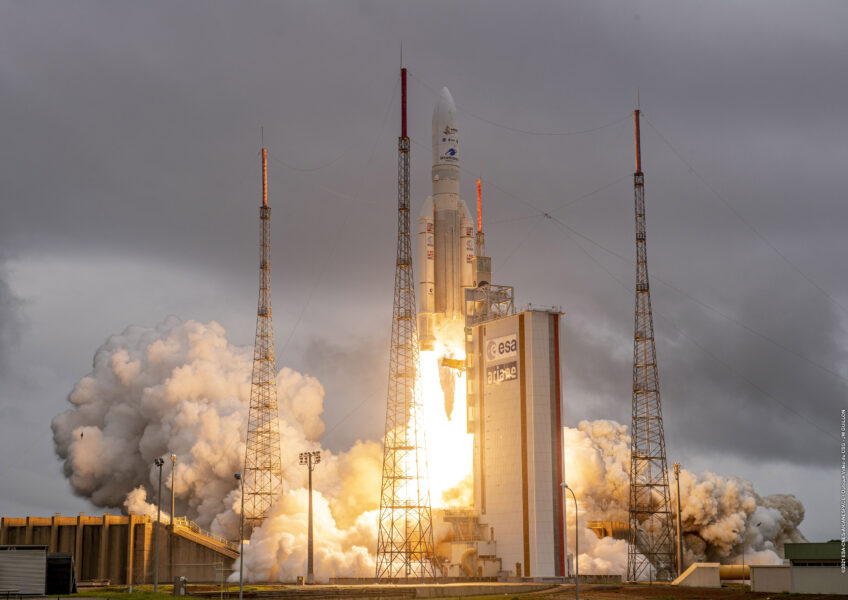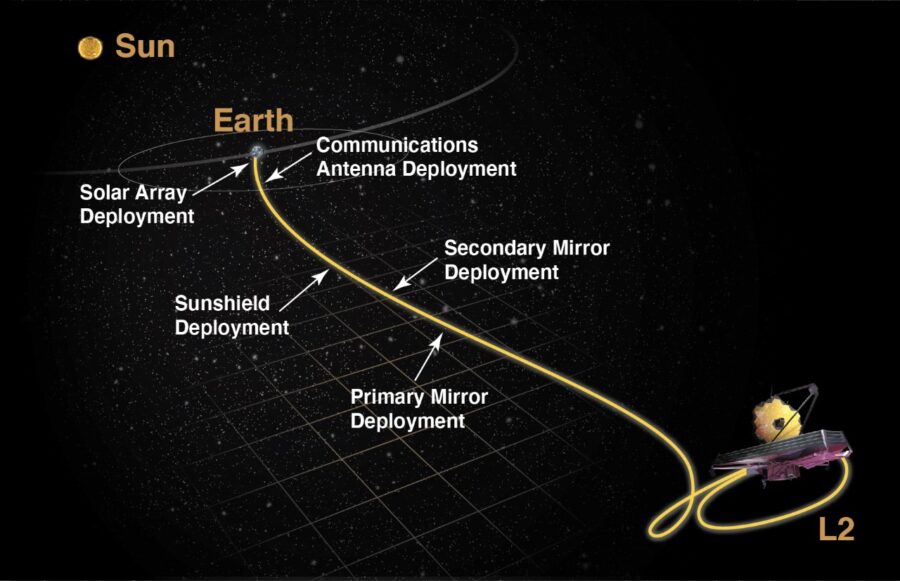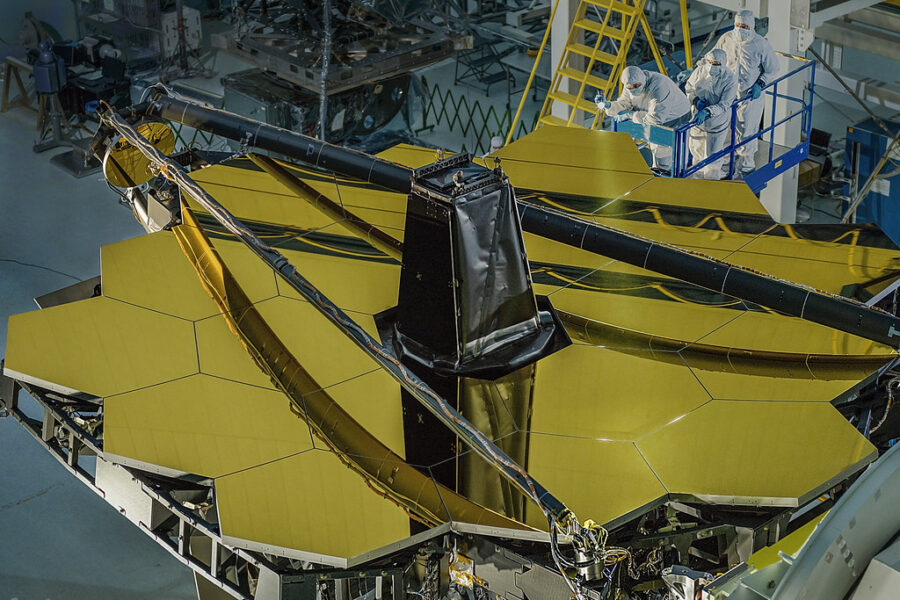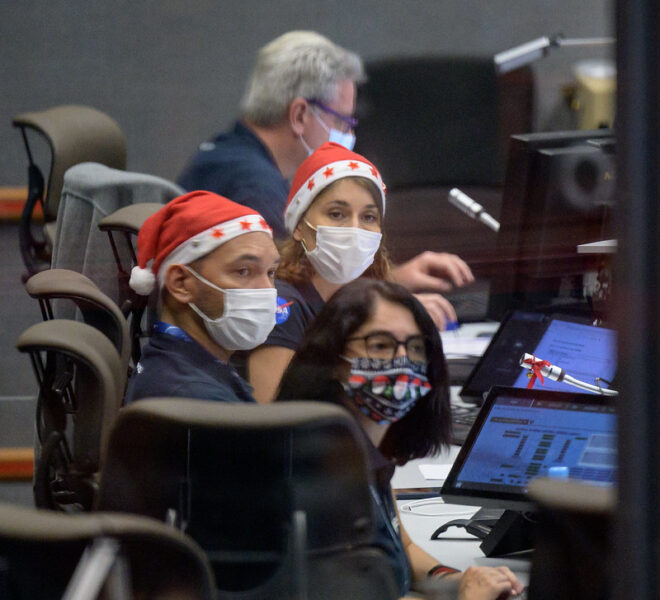Over a generation in the making, the James Webb Space Telescope is finally headed for space.

ESA / CNES / Arianespace
At last! After more than two decades of development, cost overruns, a redesign, and brushes with Congress, the James Webb Space Telescope (JWST) launched this morning on an Arianespace Ariane 5 ECA rocket on mission VA 256. Liftoff from pad Ensemble de Lancement at the Guiana Space Center in French Guiana occurred at 7:20 a.m. EST (12:20 UT) on December 25th.
We have LIFTOFF of the @NASAWebb Space Telescope!
At 7:20am ET (12:20 UTC), the beginning of a new, exciting decade of science climbed to the sky. Webb’s mission to #UnfoldTheUniverse will change our understanding of space as we know it. pic.twitter.com/Al8Wi5c0K6
— NASA (@NASA) December 25, 2021
The launch was delayed a couple times this past week, due to tracking issues and weather concerns, but the Christmas Day launch went off without a hitch. Mission controllers report that the payload is in good health, and ground stations are receiving good telemetry from the telescope. The Ariane 5 stage one booster separated just under nine minutes after liftoff. The stage two rocket motor also did its job, sending JWST on a path towards a halo orbit around the Sun-Earth L2 Lagrange point, 1.5 million kilometers (1 million miles) from Earth in the anti-sunward direction. The second stage separated from JWST 27 minutes after liftoff. Shortly afterward, at T+30 minutes after launch, JWST deployed its solar panels and reported that the spacecraft is "power positive."
Timeline to L2
Now “30 days of terror” begin, as JWST starts its career in space. First, it will take the space telescope 30 days to reach the start of its halo orbit at L2. On its way, the telescope must unfurl its 18 gold-plated beryllium mirror segments using 132 actuators. It will also have to deploy its five-layer, origami sunshield and cool down to below 50K (-223°C or -370°F) to begin the start of science operations in 2022.
NASA has a great interactive timeline for JWST's journey from Earth to its final orbit.

NASA
Both the sunshield and the distant orbit at L2 will keep the the telescope extremely cold to perform its infrared observations. But this means that unlike the Hubble Space Telescope, which flies in low-Earth orbit, JWST is beyond reach for repair. If, for example, something jams on deployment, engineers have only a few options available, such as tilting or rolling the spacecraft.
The Science of James Webb
In the 2000 proposal, JWST, then named the Next Generation Space Telescope, was envisioned to have an 8-meter mirror. In 2002, the team shrank the telescope mirror to a diameter of 6.5 meters in a Korsch telescope configuration — the smallest aperture that would still enable groundbreaking science.
JWST will push forward our understanding of the universe at wavelengths from 0.6 to 28.3 microns, performing observations that can only be done in space. A joint project between NASA, the Canadian Space Agency, and the European Space Agency, JWST is set to answer key questions for a new generation of astronomers. It will witness the formation of galaxies in the early universe, study the evolution of stars, and directly target exoplanets discovered by missions such as Kepler and TESS. Its observations will help astronomers look for signs of water vapor, carbon dioxide, and other potential markers of biological processes at work on distant worlds.
JWST has a primary mission of 10 years, although astronomers will want to keep the mission going for as long as possible.

NASA / Chris Gunn
“I’m really excited to see the capability of JWST for detailed studies of ocean worlds in the solar system — characterizing plumes or residue from them on icy worlds is very exciting for astrobiology and future missions such as Europa Clipper,” says Webb's deputy project scientist for planetary science Stefanie Milam (NASA Goddard). “I’m also looking forward to the unexpected discoveries and new science that will be enabled by Webb.”

NASA / Bill Ingalls
Unistellar’s Spotting Campaign
You can watch JWST on its way: The SETI institute has a tool to help you calculate the ephemeris for your location, which will give you all the position information you need to watch the telescope on its journey. Unistellar eVscope and eQuinox users can even try and image JWST, both en route to its final orbit and once it has deployed and fully unfurled.
It will be interesting to see JWST get to work at long last in 2022. Astronomers couldn’t ask for a better Christmas present!
 2
2









Comments
zz2b2
December 25, 2021 at 10:29 am
Can someone explain what will happen to the second stage of the Arianne 5 rocket? Thanks
You must be logged in to post a comment.
GerryH
January 6, 2022 at 9:52 am
Another question: Whilst the JWST is on route to L2, it must stay outside the cone shaped shadow of earth?
You must be logged in to post a comment.
You must be logged in to post a comment.